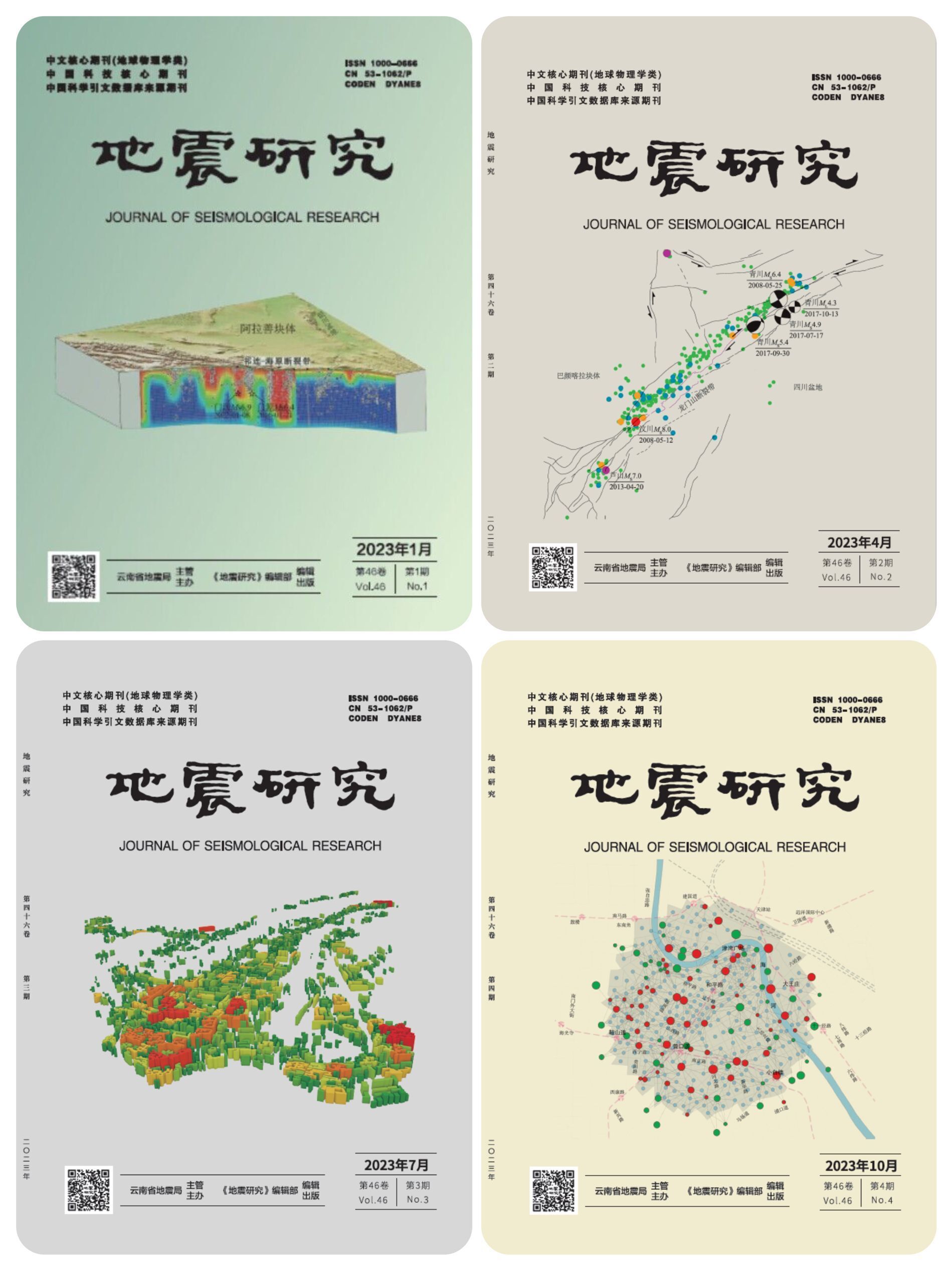[1]SHAO Lei,WANG Changzai.Application of the Density Clustering Algorithm in Machine Learning to Seismic Activity[J].Journal of Seismological Research,2025,(03):361-369.[doi:10.20015/j.cnki.ISSN1000-0666.2025.0038
]
Copy
Application of the Density Clustering Algorithm in Machine Learning to Seismic Activity
Journal of Seismological Research[ISSN 1000-0666/CN 53-1062/P] Volume:
Number of periods:
2025 03
Page number:
361-369
Column:
Public date:
2025-04-15
- Title:
- Application of the Density Clustering Algorithm in Machine Learning to Seismic Activity
- CLC:
- P315.5
- DOI:
- 10.20015/j.cnki.ISSN1000-0666.2025.0038
- Abstract:
- Aiming at the problem of effectively sub-dividing sub-regions for precise earthquake location in large-scale areas with intensive seismic activity,this paper,through multiple simulated data experiments and evaluations of various clustering algorithms in machine learning,concludes that the DBSCAN algorithm is most suitable for earthquake clustering in faults or earthquake swarms.Based on this,seismic activity studies are conducted to analyze and reveal spatial differences in the relative levels of current tectonic stress accumulation along fault zones,serving as an important foundation for analyzing the current activity patterns of faults(segments)and potential strong earthquake hazard zones.The DBSCAN algorithm was applied to cluster a total of 322 070 earthquake events in Sichuan-Yunnan region,resulting in nine distinct earthquake clusters.Among them,precise locations are determined using the double-difference earthquake location algorithm for the earthquake cluster in the intersection area of the southern segment of the Xianshuihe fault zone and the northern segment of the Anninghe fault zone,as well as for the Kangding MS6.3 earthquake sequence to the northwest,and the spatial distribution characteristics of earthquakes are also analyzed.The relocated results show that the Kangding earthquake sequence exhibits features consistent with the earthquake distribution on the strike-slip fault.The fault has an almost vertical dip angle.Earthquakes in the intersection area of the southern segment of the Xianshuihe fault zone and in the northern segment of the Anninghe fault zone are also densely distributed around the faults,with orientations generally consistent with the fault strikes.The longitudinal profile reveals the deep structural features of the fault.Furthermore,this paper investigates the spatial distribution characteristics of the b-value in the southern segment of the Xianshuihe fault zone and in the northern segment of the Anninghe fault zone from January 2009 to March 2021,revealing that the location of the Luding MS6.8 earthquake that occurred on September 5,2022 is in the area where b-value is obviously low.
- References:
-
贾漯昭,孟令媛,闫睿.2024.深度学习在地震监测预报中的应用进展[J].地震研究,47(3):336-349.
Jia L Zh,Meng L Y,Yan R.2024.Advancements of deep learning in seismic monitoring and prediction[J].Journal of Seismological Research,47(3):336-349.(in Chinese)
李正芳,周本刚.2014.利用断裂带上的低b值识别凹凸体方法的探讨——以龙门山断裂带和鲜水河断裂带为例[J].震灾防御技术,9(2):213-225.
Li Z F,Zhou B G.2014.Asperity identification based on low b-value:Application to the Longmenshan and Xianshuihe fault zone[J].Technology for Earthquake Disaster Prevention,9(2):213-225.(in Chinese)
龙锋,祁玉萍,易桂喜,等.2021.2021年5月21日云南漾濞MS6.4地震序列重新定位与发震构造分析[J].地球物理学报,64(8):2631-2646.
Long F,Qi Y P,Yi G X,et al.2021.Relocation of the MS6.4 Yangbi earthquake sequence on May 2l,2021 in Yunnan province and its seismogenic structure analysis[J].Chinese Journal of Geophysics,64(8):2631-2646.(in Chinese)
石永祥,蒋一然,宁杰远,等.2021.基于震源聚类方法确定川滇交界东部地区微震的空间分布特征[J].华北地震科学,39(2):10-16.
Shi Y X,Jiang Y R,Ning J Y,et al.2021.Spatial distribution characteristics of microearthquakes in east Sichuan-Yunnan boundary area from epicentral clustering[J].North China Earthquake Sciences,39(2):10-16.(in Chinese)
苏有锦,李永莉,李忠华,等.2003.川滇地区区域地震目录完整性最小震级分析[J].地震研究,26(S1):10-16.
Su Y J,Li Y L,Li Z H,et al.2003.Analysis of minimum complete magnitude of earthquake catalog in Sichuan-Yunnan region[J].Journal of Seimological Research,26(S1):10-16.(in Chinese)
王辉,曹建玲,荆燕,等.2012.川滇地区强震活动前b值的时空分布特征[J].地震地质,34(3):531-543.
Wang H,Cao J L,Jing Y,et al.2012.Spatio temporal pattern of b-value before major earthquakes in the Sichuan-Yunnan region[J].Seismology and Geology,34(3):531-543.(in Chinese)
王未来,房立华,吴建平,等.2021.2021年青海玛多MS7.4地震序列精定位研究[J].中国科学:地球科学,51(7):1193-1202.
Wang W L,Fang L H,Wu J P,et al.2021.The refined positioning study of the Qinghai Maduo MS7.4 earthquake sequence in 2021[J].Scientia Sinica Terrae,51(7):1193-1202.(in Chinese)
易桂喜,闻学泽.2007.多地震活动性参数在断裂带现今活动习性与地震危险性评价中的应用与问题[J].地震地质,29(2):254-271.
Yi G X,Wen X Z.2007.The application and limitation of multiple seismicity parameters to assessing current faulting behavior and seismic potential of active faule zones[J].Seismology and Geology,29(2):254-271.(in Chinese)
Aggarwal C C,Erik Z.2000.A survey of techniques for density based clustering of high dimensional data[J].Journal of pattern recognition,33(11):1659-1674.
Fang L H,Wu J P,Liu J,et al.2015.Preliminary report on the 22 November 2014 MW6.1/MS6.3 Kangding earthquake,western Sichuan,China[J].Seismological Research Letters,86(6):1603-1613.
Fang L H,Wu J P,Wang W L,et al.2013.Relocation of the mainshock and aftershock sequences of MS7.0 Sichuan Lushan earthquake[J].Chinese Science Bulletin,58(28):3451-3459.
Feng T,Wu J P,Fang L H,et al.2021.Foreshocks of the 2018 ML4.0 Shimian earthquake in the Anninghe fault and its implications for earthquake nucleation[J].Seismological Research Letters,92:1937-1949.
Jiang G Y,Wen Y M,Liu Y J,et al.2015.Joint analysis of the 2014 Kangding,southwest China,earthquake sequence with seismicity relocation and InSAR inversion[J].Geophysical Research Letters,42(9):3273-3281.
Mendoza M M,Ghosh A,Karplus M S,et al.2019.Duplex in the Main Himalayan Thrust illuminated by aftershocks of the 2015 MW7.8 Gorkha earthquake[J].Nat Geosci,12(12):1018-1022.
Ross Z E,Idini B,Jia Z,et al.2019.Hierarchical interlocked orthogonal faulting in the 2019 Ridgecrest earthquake sequence[J].Science,366(6463):346-351.
Shearer P,Hauksson E,Lin G Q.2005.Southern California hypocenter relocation with waveform cross-correlation,Part 2:Results using source-specific station terms and cluster analysis[J].Bulletin of the Seismological Society of America,95(3):904-915.
Shelly D R,Hardebeck J L.2019.Illuminating faulting complexity of the 2017 Yellowstone Maple Creek earthquake swarm[J].Geophysical Research Letters,46(5):2544-2552.
Waldhauser F,Ellsworth W L.2000.A double-difference earthquake location algorithm:Method and application to the northern Hayward fault,California[J].Bulletin of the Seismological Society of America,90(6):1353-1368.
Wiemer S,Wyss M.2000.Minimum magnitude of completeness in earthquake catalogs:example from Alaska,the western United States,and Japan[J].Bulletin of the Seismological Society of America,90(4):859-869.
Yadav R B,Bormann P,Rastogi B K,et al.2009.A homogeneous and complete earthquake catalog for northeast India and the adjoinning region[J].Seismological Research Letters,80(4):609-627.
Zhou Y J,Yue H,Fang L H,et al.2022.An earthquake detection and location architecture for continuous seismograms:phase picking,association,location,and matched filter(PALM)[J].Seismological Research Letters,93(1):413-425.
- Similar References:
Memo
-
Last Update:
2025-04-15

